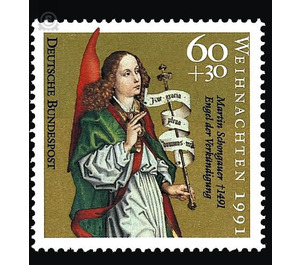chrismas: 500th anniversary of death of Martin Schongauer - Germany / Federal Republic of Germany 1991 - 60 Pfennig
| Country | Germany / Federal Republic of Germany |
| Issue Date | 1991 |
| Face Value | 60.00 |
| Color | brown |
| Perforation | K 13 3/4 |
| Printing Type | 5-color offset |
| Stamp Type | Postage stamp |
| Item Type | Stamp |
| Chronological Issue Number | 1451 |
| Chronological Chapter | GER-BRD |
| SID | 778411 |
| In 31 Wishlists | |
This year's Christmas stamps show motifs from the works of Martin Schongauer on the occasion of his 500th anniversary. Martin Schongauer, also known as "Hipsch Martin" by his contemporaries for his art, is one of the most important German artists of the second half of the 15th century. His panel paintings secured fame and prestige far beyond the borders of his hometown of Colmar, and his engravings were well received at home and abroad. The young Dürer also appreciated the older master and wanted to stop by on his journeyman's journey with him, but he no longer met him during his lifetime. As is so often the case with artists of the Middle Ages, little is known about the life of Martin Schongauer. He probably was born around 1450 as probably the youngest son of the goldsmith Caspar Schongauer in Colmar. While the two eldest brothers learned the craft of the father and Ludwig was allowed to become a painter, Martin's career as an ecclesiastical career was determined. So he was enrolled at the University of Leipzig in 1464/65. But it only took a year, apparently, to persuade his father to let him learn painting skills as well. His teachers are no longer handed down by name. The stylistic proximity to the Alsatian masters of the Stauffenberg triptych (Colmar, Unterlindenmuseum) and the Bergheimer Tafeln (Colmar, Unterlindenmuseum) indicates the local workshop tradition. The journeyman journey took him to Burgund and the Netherlands, as far as the surviving works tell us. Above all, the works of Rogier van der Weyden (1399 / 1400-464) and Dierick Bouts (around 1410-1475) impressed the young painter and shaped his conception of space and figures sustainably. As the series of lifelike head studies of Spanish Moors suggests, the Iberian peninsula was another stage in his journey. In 1471 he returned to Colmar and settled there soon as a master. In 1488, the commission to paint the mural for Breisach Cathedral with the theme of the Last Judgment required his move to Breisach, where he died on February 2, 1491. Schongauer probably learned about the technique of engraving from the goldsmith's art, with which he could be trusted in his father's workshop. We have received 116 engravings bearing his mark, including the frequently copied "Temptation of St. Anthony" and the "Great Cross Carrying." Until then, engravings had been used as replicas of other genres or as templates for them. Along with the refinement of the technique, they now gained independent image value in the hands of the painter Schongauer. They were no longer a means to an end but became autonomous works of art. In view of Schongauer's fundamental importance for the development of graphic art, his outstanding position in German panel painting of the late Middle Ages has almost been forgotten, especially since only a handful of works have been preserved. But the altarpiece of the "Maria im Rosenhag" (Colmar, St. Martin), greatly reduced in the 18th century, dated 1473, is secured for Schongauer. On the basis of style-critical investigations, we can also attribute some other altarpieces and devotional pictures to him. In all these works, his constant effort to obtain the linear perspective of the pictorial space becomes visible. The sculptural modeling of the figures achieved through the use of light and shadow as well as their clear and expansive composition are able to increase the impression of depth. The figures of the altarpieces have their own solemn dignity and ideal beauty. However, where Schongauer finds scope for freer design, as is the case in devotional images, he gives loving attention to the realistic depiction of persons and events. By taking up elements of the Dutch tradition with these design elements in order to immediately process them independently, Martin Schongauer brings Upper-Rhine art to new pictoriality and expressiveness and in this way prepares the development of Dürer's painting fundamentally. (Text: Petra Dietz M.A., Bonn)


